Ventilation supplies fresh air, purifies, ionizes streams, controls humidity and heat. Filtration removes allergens, dust, microorganisms and odors from the atmosphere. Correct ventilation design plays a major role in the process of further operation, providing a comfortable microclimate in a residential or public space.
- What is ventilation
- Ventilation design stages
- Features of drawing up a project and basic subtleties
- Recommended equipment types
- Typesetting system
- Monoblock system
- Performing calculations
- Calculation of air exchange
- Aerodynamic calculation
- Air distribution calculation
- Acoustic calculation
- Ventilation project composition
- Initial data
- The grafical part
- Descriptive part
What is ventilation
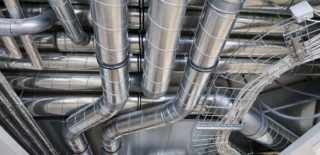
Air exchange in the building is organized so that a person can control the ventilation. Ventilation means the simultaneous supply of oxygen and the removal of exhaust air and is divided into supply and exhaust systems.
Airing can be of natural or forced type. In both cases, the error-free installation and design of ventilation systems is important. Incorrect calculations, the absence of a graphic plan leads to a loss of efficiency and a decrease in the quality of the microclimate.
Ventilation design stages
The first stage is a feasibility study project. The type of system is selected, the areas and locations of installation of ventilation units and pipelines are determined. At the stage, a preliminary installation scheme is drawn up and the estimated cost of the work is calculated, taking into account the materials. The stage ends with familiarizing the customer with the project and approving the plan.
At the second stage, working documentation is developed on the basis of preliminary documentation. The volume of equipment, elements is determined, accurate calculations of air ducts, aerodynamics, hydraulics, and noise level are carried out. Drawings are made with specifications and details, the documentation is handed over to the performers.
Features of drawing up a project and basic subtleties
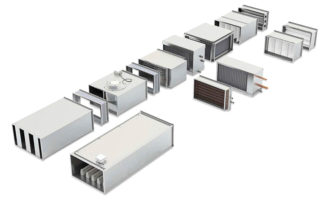
For each room, the calculated and actual air exchange is determined based on the readings of heat and moisture release and the optimal conditions are found to ensure the desired characteristics of the atmosphere.
The ventilation project includes the calculation and description of the main indicators:
- air, heat and cold performance of the ventilation unit;
- the number and type of centralized and autonomous air conditioners and the place of their installation;
- number and type of chillers, turbines and pumps;
- equipment power costs;
- the total weight of the system.
When choosing equipment, its technical indicators are taken into account. Equipment and components must provide the required air exchange rate.
Recommended equipment types
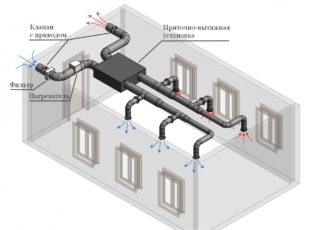
Low-power ventilation units are used for housing, the optimal solution is the supply and exhaust ventilation scheme.
Systems are subdivided according to the criteria:
- air supply option;
- appointment;
- method of exchange of streams;
- constructions.
Some installations use fans, others require air conditioning. Household recuperators are used to supply heated air masses. The system uses dehumidifiers or flow humidifiers, ionizers, filtering installations, valves and air dampers are installed.
Typesetting system
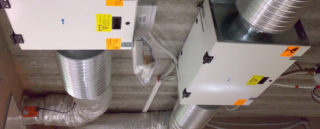
The scheme got its name due to a certain composition of units, which are sequentially recruited according to technical parameters. Modularity facilitates a variety of options and system selection for the needs of a particular house or apartment. Typesetting systems provide air exchange at the level of 50 m³ / h - 15 thousand m³ / h. The circuit nodes are connected to rectangular and round air ducts.
The systems work effectively when ventilating offices, housing in private and multi-apartment buildings, sales areas, warehouses and production workshops.
Monoblock system
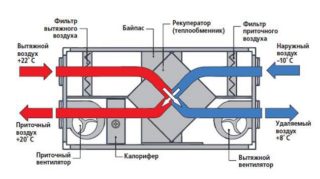
The functional equipment is combined in one unit. The system includes heat recovery to save heat while creating comfort.
The following units are installed in a single body:
- filter;
- heat exchanger;
- turbine;
- absorber of noise and vibration;
- automation elements, etc.
Monoblock systems with recuperators operate autonomously or combined with air conditioners. The removed heated streams pass through the exchanger, where they give off part of the heat to the fresh air, which minimizes the use of heaters for heating.
Performing calculations
In a private house and apartment, the design of ventilation systems in terms of the hood is done taking into account a single air exchange, while the supply system gives a double replacement of the mass. Part of the supplied air escapes through the cracks of window and door openings, and the exhaust system is not overloaded.
In the multi-apartment sector, there is no ban on the installation of supply fans, while the installation of exhaust turbines in the openings of the ventilation shaft is sometimes not allowed.
Calculation of air exchange

To obtain the desired air exchange, two values are calculated: by the number of people and by the multiplicity, after which the largest indicator is selected.
Air exchange by the number of people is determined by the formula L = N Lnwhere:
- L - required production of the supply system (m³ / h);
- N -number of people;
- Ln -air norm per person (m³ / h).
The last value is taken for people at rest 30 m³ / h, and the standard SNiP figure is 60 m³ / h.
The multiplicity is calculated according to the formula L = p S Hwhere:
- L -required production of the supply system (m³ / h);
- p -air exchange rate (for housing - from 1 to 2, for offices - from 2 to 3);
- S -room area (m²);
- H -room height (m).
After calculation, the total required ventilation capacity is obtained.
Aerodynamic calculation
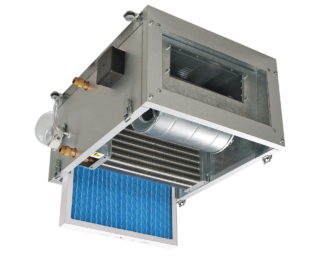
The calculation assumes that the air flow rate decreases with distance from the ventilation turbine. It is done to select the cross-sectional area and parameters of the air ducts and calculate the head losses in the system.
The design of exhaust ventilation in terms of aerodynamics includes two stages:
- determination of the characteristics of the longest section of the pipeline;
- coordination of other main sections with them.
Aerodynamic calculations are carried out by technicians who accurately take into account all the nuances of the system.
Air distribution calculation
Calculation of the air flow distribution index is important in the design of industrial ventilation. The calculation allows you to maintain a comfortable climate in the workshop without changing technology and while ensuring the quality of the final product.
As a result, an even distribution of air is achieved in all areas of a large room, while the air indicators remain in the standard range. The economic and sanitary-hygienic efficiency of the ventilation system depends on the correct calculation.
Acoustic calculation
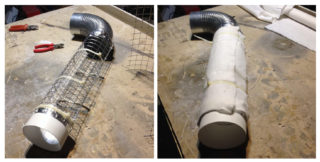
The calculation allows you to determine the source of noise, its technical characteristics and develop measures to prevent or reduce sound and vibration. Design points are determined in the pipeline, where the calculation of the degree of sound pressure is made.
The obtained values are compared with the standard parameters and measures are taken to reduce the negative effects. After the measures are reflected in the ventilation project, new calculations are made taking into account the added elements.
Ventilation project composition
The main set includes general information on the drawings with an indication of the list of working diagrams and plans, as well as a list of attached calculations, technical documents and links to certain sources. Provides a list of sets of executive drawings.
General guidelines include a list of grounds for drawing up documentation, for example, a project assignment, a feasibility study, approved justifications for investments in the construction of simple structures. The description contains building rules and regulations that must be followed.
Initial data
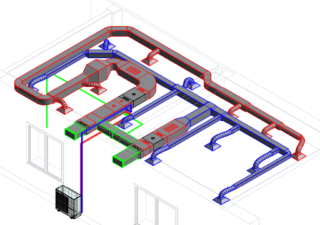
The design is carried out on the basis of an engineering assignment, architectural schemes and a design project of the building. The project is being coordinated with state supervision and control bodies, builders and other services.
The initial information includes information:
- location and adjacent buildings;
- climatic data of the region, temperature, wind speed;
- information about the operation of the building (work schedule, finding tenants).
A constructive description of the building is given, its location relative to the cardinal points. A list of rooms is given in the form of a table with an indication of the volume and floor area.
The grafical part
Drawings are developed at the stage of detailed design and, in addition to the main set, include a detailing of intersections and nodes of the main equipment with a drawing of the piping of devices. The primary supply and removal equipment is presented in the drawings in the form of a structural image.
The equipment for the termination of the ventilation caps on the roof is shown schematically. The drawings contain tables showing the dimensions of the ventilation ducts, and the areas for preventive maintenance. Special notes are written on each drawing.
Descriptive part
The explanatory note provides information on the energy consumption and power of the electric fan and other equipment. The characteristics and properties of the ventilation system are described, for example, dimensions, shape of pipelines, energy consumption.
A table of indicators for calculating the main line for rooms is compiled, and the basics of designing automatic modules for controlling the system are given. Equipment specifications are added, ventilation line diagrams are inserted in perspective view.
The explanatory part contains information about the required certificates and licenses for work, coordination of the ventilation plan with architects, designers and constructors.








